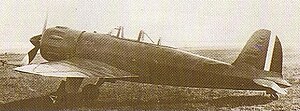The F.5 was developed in parallel with the Caproni Vizzola F.4, with which it shared a common airframe. Design began in late 1937 by a team led by F. Fabrizi. The aircraft had a welded steel-tube fuselage and wooden wings; the fuselage was covered with flush-riveted duralumin, while the wing had a stressed plywood skin.
The F.5 prototype first flew on 19 February 1939. The aircraft displayed very high maneuverability during official testing, prompting an order for both a second prototype and 12 preproduction models. The last of the preproduction aircraft was selected for use as a prototype in a renewed F.4 program, but the rest of the F.5 order was delivered to the Regia Aeronautica (Italian Royal Air Force).
No F.5 production models were built as Caproni decided to produce the more developed Caproni Vizzola F.6M fighter instead.
The Regia Aeronautica assigned the 11 preproduction F.5 fighters to the 300° Squadriglia, 51° Stormo for operational use. By 1942, they were serving as night fighters in the 167° Gruppo.

The F.5 was offered to foreign customers. It has been said that the Aeroplani Caproni subsidiary in Peru acquired the license rights for local manufacture, but no F.5s were ever built in Peru.
General characteristics
Length: 7.90 m
Wingspan: 11.3 m
Height: 3 m
Wing area: 17.6 m2
Empty weight: 1,850 kg
Gross weight: 2,238 kg
Powerplant: 1 × Fiat A.74 R.C.38 14-cyl. air-cooled radial piston engine, 649 kW (870 hp) at take-off
Maximum speed: 510 km/h
Range: 770 km at 455 km/h
Service ceiling: 9,500 m
Time to altitude: 6,500m in 6min 30s
Guns: 2 × 12.7 mm (0.5 in) forward-firing Breda-SAFAT machine guns



Ei kommentteja:
Lähetä kommentti
Kaikenlaiset kommentit ovat tervetulleita.